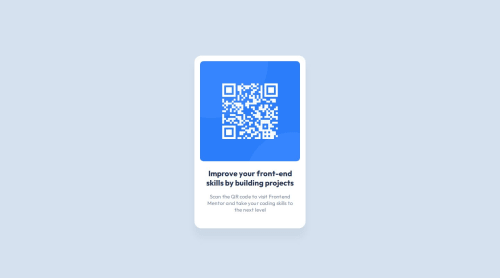QR Code using CSS

Solution retrospective
I'm most proud of having the final product look very similar to the design. Having access to the figma file is very helpful to the process. Next time I should organize all the font styles and colors before I start coding so I don't have to go around looking for them in the middle of coding.
What challenges did you encounter, and how did you overcome them?I had a bit of trouble with flex. I mistakenly tried to center the container in the child instead of the parent class, which ended up in me centering it horizontally only. I figured out that display: flex should have been in the parent, and upon changing it, I successfully centered it vertically.
What specific areas of your project would you like help with?I am not sure if the code I wrote could have been written more efficiently. I think I have a habit of writing excess code, or doing things in a way that use more code than necessary. If anyone has more effective ways that I could implement, please let me know.
Please log in to post a comment
Log in with GitHubCommunity feedback
- @Zy8712
Your site looks great and your code is really minimal. Nice work!
Some things I'd suggest you to change:
- use
<h1>instead of<h3>, heading tags are meant to be used in order from h1 to h6 without any skips. All of these heading tags come with default font sizes which can be modified using thefont-sizeattribute - the use of the
<article>tag is perfectly fine, though most people would include the<main>tag for their page's main content
Hope you find this feedback useful 👍
Marked as helpful - use
Join our Discord community
Join thousands of Frontend Mentor community members taking the challenges, sharing resources, helping each other, and chatting about all things front-end!
Join our Discord